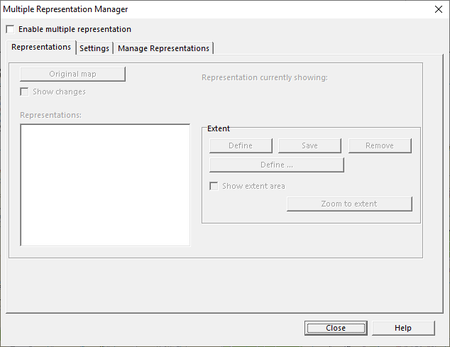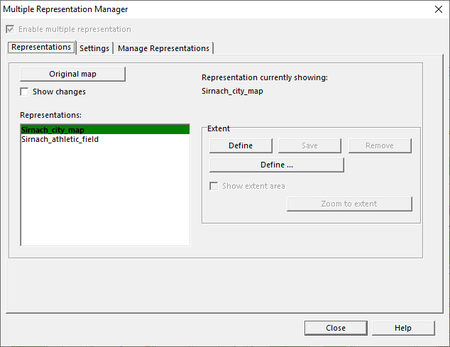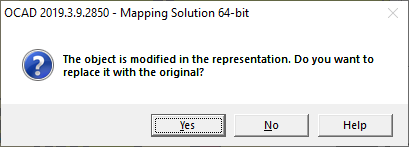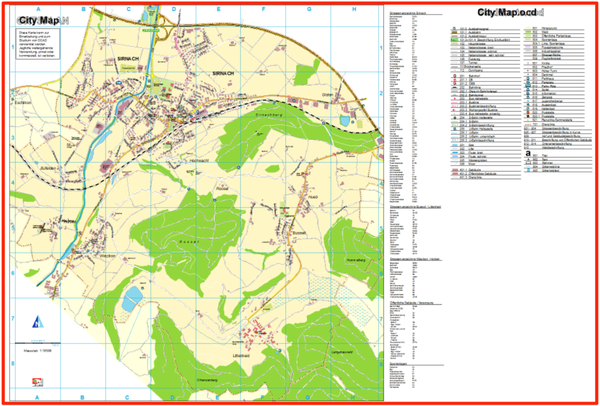Multiple Representation: Difference between revisions
No edit summary |
No edit summary |
||
| (19 intermediate revisions by 3 users not shown) | |||
| Line 1: | Line 1: | ||
==What is Multiple Representation in OCAD? [[File:Mas40px.png|This function is available in OCAD Mapping Solution.|link=https://www.ocad.com/en/products/ocad-for-cartography]] == | |||
'''Multiple representation''' enables the ability to store different states of objects in one single OCAD file. To show these different states of objects, you need to create multiple representations. After you created a new representation and set it active, you start with the original map and can alter objects or add new ones. The original map won't be changed, but just your representation. This can be helpful for example when you want to translate a city map to another language. Just add a new representation where you translate the labels. If you need to change objects in the original map, these changes are automatically assumed to the new representation. For more examples see [[#Examples:_How_OCAD_Multiple_Representation_is_meant_to_work|Examples: How OCAD Multiple Representation is meant to work]]. | |||
The multiple representation is available in OCAD Mapping Solution. OCAD maps with an active multiple representation can only be opened with this edition. | |||
[[File:Hint.jpg]][http://www.ocad.com/docs/Anleitung_OCAD_Multirepraesentation.pdf Anleitung OCAD Multi-Repräsentation (deutsch)] | |||
==Multiple Representation Manager== | |||
Click on '''Multiple Representation''' -> '''Manager…''' to open the manager. The multiple representation manager serves for the activation and management of the representations. You can only activate the multiple representation in the multiple representation manager. | Click on '''Multiple Representation''' -> '''Manager…''' to open the manager. The multiple representation manager serves for the activation and management of the representations. You can only activate the multiple representation in the multiple representation manager. | ||
[[File:MRM05.PNG|450px]] | |||
Click in the head of the dialog on '''Enable multiple representation''' to activate the multiple representation. The multiple representation manager is a non-modal dialog, you can edit the map while the dialog is open. | |||
=== | [[File:MRM01.PNG|450px]] | ||
===Representations=== | |||
After the activation of the multiple representation and the creation of two representations "Sirnach_city_map" and "Sirnach_athletic_field" in the '''Manage Representations''' tab, the dialog looks like this: | |||
[[File:MR_Representations.png|450px]] | |||
=====Extent===== | |||
In the section '''Extent''', you have the possibility to define the border of a representation. Click on the '''Define''' button and define the extent of the representation with the black rectangle in the map window. Click on '''Save''' and activate '''Show extent area'''. The extent gets shown with a red frame in the map window. You can remove the extent, if you click on '''Remove''' or you can overwrite it by defining and saving a new one.<br> | |||
[[File:hint.jpg|hint]] You don't need to define an extent, but it makes it easier for you to keep the overview. Furthermore, you can use the defined extent as an input, when you like to export or print the representation. | |||
If you have defined an extent for the currently showing representation, you can click on the button '''Zoom to extent''' to zoom to the extent of this representation. | |||
=====Representations===== | |||
The currently showing representation is in this example the Sirnach_city_map. With a click on the favored representation in the box, you can change between the representations. You see the '''Representation currently showing''' in the top right of the dialog. | |||
=====Original Map===== | |||
If you click on the button '''Original Map''', the original map is shown in the map window. | |||
=====Show Changes===== | |||
If a representation is shown, you can activate the option '''Show changes'''. All objects, that have been moved, changed or deleted compared to the original map, are shown in the Keyline modus, like the label „Ortsplan“ in following example:<br> | |||
[[File:MRM15.PNG|450px]] | |||
<br><br> | |||
The red frame in the map is the defined extent of the currently showing representation. The label “City map” would be missing in the Sirnach_athletic_field if it wouldn’t have been moved to a new position within in the representation extent.<br> | |||
[[File:MRM16.PNG|450px]] | |||
===Settings=== | ===Settings=== | ||
You can manage the properties for deleting or updating objects of the original map in the '''Settings''' tab. | |||
[[File:MR_Settings.png|450px]] | |||
=====Delete Objects===== | |||
*; '''Ask every object''' | |||
:If an object is deleted in the original map, a dialog appears and asks, if you also want to delete the object in the representations or if you want to keep it there. This dialog appears once per object and representation. | |||
*; '''Delete only original, keep in representations''' | |||
:If an object is deleted in the original map, it is kept in the representations. | |||
*; '''Delete original and representations''' | |||
:If an object is deleted in the original map, it is also deleted in the representations. | |||
:[[File:hint.jpg|hint]] If an object is deleted in the representation, there are no effects to the original map and the other representations. To delete an object in all representations, you have to delete it in the original map. | |||
=====Update of original objects with representation(s)===== | |||
Here you can define what will happen, if an object is changed in the original map, that has already been changed in a representation before. | |||
*; '''Ask every object''' | |||
:If an object is changed in the original map, a dialog appears to ask if the changes should be assumed to each representation. This dialog appears once per object and representation. | |||
*; '''Always update representation objects''' | |||
:If an object is changed in the original map, the changes are automatically assumed to all representations. | |||
===Manage Representations=== | |||
[[File: | [[File:MR_ManageRepresentations.png|450px]] | ||
=====Add Representation===== | |||
Enter the name of the representation in the field '''Representation name''' and click on the button '''Add'''. | |||
You see the added representation in the list of the '''Representations''' tab. | |||
=====Delete Representations===== | |||
A representation can be deleted, if it isn’t the currently showing representation. Click (once, no double click) on the representation in the list and click on the button '''Remove'''. | |||
=====Rename Representations===== | |||
A representation can be renamed. Chosse an existing representation from the dropdown-list, enter a new name and click on '''Rename representation'''. | |||
==Copy Objects from the Original Map to the Representation== | |||
If you deleted one or several objects | If you have deleted (e.g. by mistake) one or several objects in a representation, you can undo this action. Go to the original map, right-click on a selected object, click on '''Copy in representation''' and choose in which representation you want to copy the object. | ||
[[File: | [[File:MRM17.PNG|450px]]<br><br> | ||
This message appears if the object is already in the representation: | |||
[[File:MRM19.PNG]]<br><br> | |||
This message appears if the object has already been changed in the representation: | |||
[[File: | [[File:MRM18.PNG]] | ||
The map | ==Disable multiple representation== | ||
The multiple representation can be disabled in an OCAD map by going to '''Multiple Representation''' -> '''Disable multiple representation...'''<br> | |||
The contents of the representations get lost. | |||
==Print and Export== | |||
If you print or export the map, the currently showing representation/original map is printed or exported. | |||
==Restrictions== | |||
The function in the menu '''Thematic Map''' can’t be used, if the multiple representation is activated. | |||
Following functions are only available, if the original map is shown: | |||
* Import files<br> | |||
* Functions in the menus '''Map''', '''Database''', '''DEM''' and '''GPS''' | |||
==Examples: How OCAD Multiple Representation is meant to work== | |||
The representation "Sirnach_city_map" is an Englisch translation of the original German map. Just the labels are different, the content of the map ist the same. | |||
[[File:MRM20.PNG|600px]] | |||
[[File: | |||
For the representation "Sirnach_athletic_field" an approach plan was created. It contains additional labels and arrows. | |||
[[File:MRM21.PNG|599px]] | |||
---- | ---- | ||
Back to [[Main Page]] | Back to [[Main Page]] | ||
Latest revision as of 12:22, 5 December 2019
What is Multiple Representation in OCAD? 
Multiple representation enables the ability to store different states of objects in one single OCAD file. To show these different states of objects, you need to create multiple representations. After you created a new representation and set it active, you start with the original map and can alter objects or add new ones. The original map won't be changed, but just your representation. This can be helpful for example when you want to translate a city map to another language. Just add a new representation where you translate the labels. If you need to change objects in the original map, these changes are automatically assumed to the new representation. For more examples see Examples: How OCAD Multiple Representation is meant to work.
The multiple representation is available in OCAD Mapping Solution. OCAD maps with an active multiple representation can only be opened with this edition.
![]() Anleitung OCAD Multi-Repräsentation (deutsch)
Anleitung OCAD Multi-Repräsentation (deutsch)
Multiple Representation Manager
Click on Multiple Representation -> Manager… to open the manager. The multiple representation manager serves for the activation and management of the representations. You can only activate the multiple representation in the multiple representation manager.
Click in the head of the dialog on Enable multiple representation to activate the multiple representation. The multiple representation manager is a non-modal dialog, you can edit the map while the dialog is open.
Representations
After the activation of the multiple representation and the creation of two representations "Sirnach_city_map" and "Sirnach_athletic_field" in the Manage Representations tab, the dialog looks like this:
Extent
In the section Extent, you have the possibility to define the border of a representation. Click on the Define button and define the extent of the representation with the black rectangle in the map window. Click on Save and activate Show extent area. The extent gets shown with a red frame in the map window. You can remove the extent, if you click on Remove or you can overwrite it by defining and saving a new one.
![]() You don't need to define an extent, but it makes it easier for you to keep the overview. Furthermore, you can use the defined extent as an input, when you like to export or print the representation.
You don't need to define an extent, but it makes it easier for you to keep the overview. Furthermore, you can use the defined extent as an input, when you like to export or print the representation.
If you have defined an extent for the currently showing representation, you can click on the button Zoom to extent to zoom to the extent of this representation.
Representations
The currently showing representation is in this example the Sirnach_city_map. With a click on the favored representation in the box, you can change between the representations. You see the Representation currently showing in the top right of the dialog.
Original Map
If you click on the button Original Map, the original map is shown in the map window.
Show Changes
If a representation is shown, you can activate the option Show changes. All objects, that have been moved, changed or deleted compared to the original map, are shown in the Keyline modus, like the label „Ortsplan“ in following example:

The red frame in the map is the defined extent of the currently showing representation. The label “City map” would be missing in the Sirnach_athletic_field if it wouldn’t have been moved to a new position within in the representation extent.
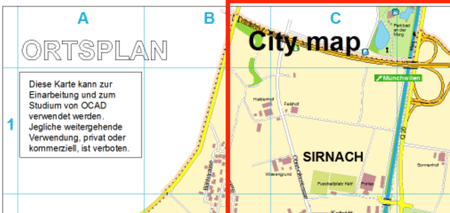
Settings
You can manage the properties for deleting or updating objects of the original map in the Settings tab.
Delete Objects
- Ask every object
- If an object is deleted in the original map, a dialog appears and asks, if you also want to delete the object in the representations or if you want to keep it there. This dialog appears once per object and representation.
- Delete only original, keep in representations
- If an object is deleted in the original map, it is kept in the representations.
- Delete original and representations
- If an object is deleted in the original map, it is also deleted in the representations.
 If an object is deleted in the representation, there are no effects to the original map and the other representations. To delete an object in all representations, you have to delete it in the original map.
If an object is deleted in the representation, there are no effects to the original map and the other representations. To delete an object in all representations, you have to delete it in the original map.
Update of original objects with representation(s)
Here you can define what will happen, if an object is changed in the original map, that has already been changed in a representation before.
- Ask every object
- If an object is changed in the original map, a dialog appears to ask if the changes should be assumed to each representation. This dialog appears once per object and representation.
- Always update representation objects
- If an object is changed in the original map, the changes are automatically assumed to all representations.
Manage Representations
Add Representation
Enter the name of the representation in the field Representation name and click on the button Add. You see the added representation in the list of the Representations tab.
Delete Representations
A representation can be deleted, if it isn’t the currently showing representation. Click (once, no double click) on the representation in the list and click on the button Remove.
Rename Representations
A representation can be renamed. Chosse an existing representation from the dropdown-list, enter a new name and click on Rename representation.
Copy Objects from the Original Map to the Representation
If you have deleted (e.g. by mistake) one or several objects in a representation, you can undo this action. Go to the original map, right-click on a selected object, click on Copy in representation and choose in which representation you want to copy the object.
This message appears if the object is already in the representation:
This message appears if the object has already been changed in the representation:
Disable multiple representation
The multiple representation can be disabled in an OCAD map by going to Multiple Representation -> Disable multiple representation...
The contents of the representations get lost.
Print and Export
If you print or export the map, the currently showing representation/original map is printed or exported.
Restrictions
The function in the menu Thematic Map can’t be used, if the multiple representation is activated. Following functions are only available, if the original map is shown:
- Import files
- Functions in the menus Map, Database, DEM and GPS
Examples: How OCAD Multiple Representation is meant to work
The representation "Sirnach_city_map" is an Englisch translation of the original German map. Just the labels are different, the content of the map ist the same.
For the representation "Sirnach_athletic_field" an approach plan was created. It contains additional labels and arrows.
Back to Main Page

